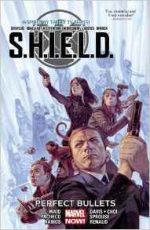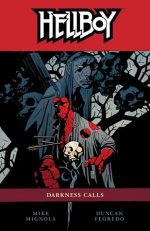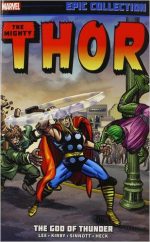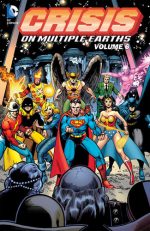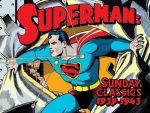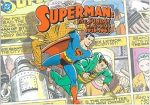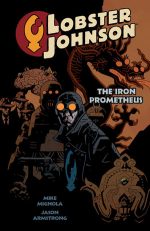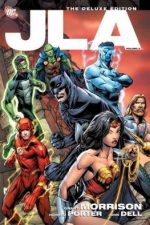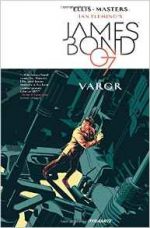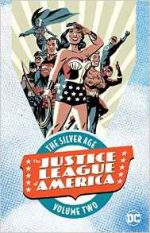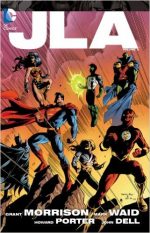
By Grant Morrison, Mark Waid, Mark Millar, Howard Porter, Mark Pajarillo, Arne Jorgensen John Dell & various (DC Comics) ISBN: 978-1-4012-3832-2
Infinitely rewarding comics concepts such as the Justice League of America generally wax and wane with terrifying regularity over the decades: constantly being reinvented for fresh generations before tailing off until the next big idea.
After numerous reboots came and went, in 1997 Grant Morrison, Howard Porter & John Dell, took their shot: offering a back-to-basics line-up of heroes battling in cutting-edge conceptual chillers and thrillers.
The result was a gleaming paradigm of comicbook perfection which yet again started magnificently before gradually losing the attention and favour of its originally rabid fan-base. Apparently, we’re a really shallow, jaded bunch, us comics fans…
These stories were smart, fast-paced, compelling, challengingly large-scale and drawn with effervescent vitality. With JLA you could see on every page all the work undertaken to make it the best it could be. Moreover their example – at least initially – was mirrored by all other creators brought in to craft the hero-team’s later adventures…
This third Deluxe Edition (available in hardback, paperback and eBook formats) gathers issues #18-31 of the resurgent series, spanning May 1998 to July 1999: re-presenting astounding epics of cosmic wonder and universal upheaval which still pack a punch nearly two decades later…
With a team that consists of Superman, Batman, Wonder Woman, Martian Manhunter, Hourman, Flash, Green Lantern, Aquaman, Connor Hawke (a second generation Green Arrow), Plastic Man, Huntress, Steel, fallen angel Zauriel, covert information resource Oracle and New Gods Orion and Big Barda you’d imagine there would be little the JLA had to worry about, but you’d be wrong…
Scripter Mark Waid steps in for ‘The Strange Case of Dr. Julian September’: a scary, surreal and utterly enthralling two-part thriller that begins with ‘Synchronicity’ (illustrated by Porter & Dell) which finds the World’s Greatest Heroes hard-pressed to combat the rewriting of Reality by a luck-bending scientist. Walden Wong then joins the art team to conclude the spectacular last-chance battles against a world riotously remaking itself in the ‘Seven Soldiers of Probability’ – featuring a particularly impressive guest-shot by lapsed former JLA-er the Atom…
Adam Strange then makes one of his far too infrequent appearances to combat a splendid ‘Mystery in Space’ (Waid, Jorgensen & Meikis) as the League travels to distant planet Rann only to be betrayed and enslaved by one of their oldest allies; an epic encounter resoundingly resolved in the Doug Hazlewood-inked ‘Strange New World’, after which Morrison, Porter & Dell return for a multi-layered extravaganza as the team’s most uncanny old foe resurfaces…
‘It’ finds the world under the mental sway of insidious space invader Starro, where only a little boy, aided by the (post Neil Gaiman) Morpheus/Lord of Dreams/Sandman can turn the tide in the breathtaking finale ‘Conquerors’…
Issues #24 begins with Morrison, Porter & Dell introducing a brand-new super-team in ‘Executive Action’ as the American military, in the form of General Wade Eiling, announces its own metahuman unit “The Ultramarine Corpsâ€.
The four-person squad is officially tasked with pre-emptively defending America from paranormal threats, but as the JLA (and long-term DC fans) are well aware, Eiling has a long history of covert, “black-bag†and just plain illegal operations compelling the JLA to remain duly suspicious…
When the Corps steal the artificial body of League bête noir Shaggy Man everyone concerned knows it bodes badly, but even they are unprepared for ‘Scorched Earth’ wherein Eiling pits his Ultramarines and the US army against the heroes…
Meanwhile the New God JLA-ers are preparing for the imminent cosmic threat they had enlisted to confront whilst Batman, Huntress and Plastic Man infiltrate the General’s base to discover his real motives…
The spectacular, revelatory conclusion comes in ‘Our Army At War’ (with art by Mark Pajarillo & Wong) as Eiling’s plans are exposed and the truth about the Ultramarines uncovered. The net result is the disillusioned, lied-to super-soldiers setting up their own operation independent of any national influence and beginning to gather like-minded costumed champions for a First-Strike force. They would soon return…
Time-travelling future-robot Hourman replaced the Martian Manhunter for a while at this juncture as Mark Millar, Pajarillo, Wong & Marlo Alquiza craft ‘The Bigger They Come…’ a delightfully retrospective yarn which sees size-changing physicist Ray Palmer return to active duty as the Atom after power-stealing super-android Amazo is accidentally reactivated.
The main event of this volume is JLA/JSA team-up ‘Crisis Times Five’ by Morrison, Porter & Dell. The Thunderbolt Genie of Johnny Thunder returns with a new master and reality is grievously assaulted by unnatural disasters and magical monsters. Somehow, Triumph, an old friend and foe of the League is at the heart of it all, but promptly finds himself trapped in a true Devil’s Bargain…
With reason on the run in ‘World Turned Upside Down…’ the assembled champions of League and Society battle rampant magical chaos, all the while revealing and retrofitting a little more secret history. The assorted sprites, Djinn and pixies of the Silver Age DC Universe are revealed to be something far more sinister, and ‘Worlds Beyond’ finds those wishing wonders reduced to civil war; concluding with ‘Gods & Monsters’ as a vast army of united heroes save reality in the nick of time and space…
Compelling, challenging and never afraid of nostalgia or laughing at itself, JLA was an all-out effort to be Smart and Fun. For that brief moment in the team’s long, chequered career these were definitely the “World’s Greatest Superheroesâ€, in increasingly ambitious epics reminding everybody of the fact. This is the kind of thrill nobody ever outgrows repackaged in graphic novels to be read and re-read forever…
© 1998, 1999, 2012 DC Comics. All Rights Reserved.

